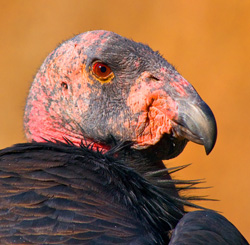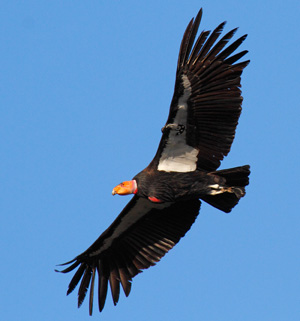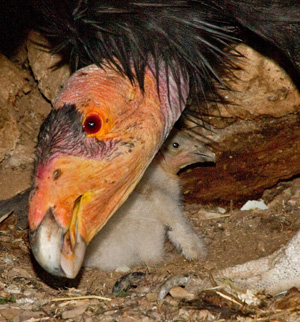Campus News
Lead poisoning blocks recovery of California condor population
Study confirms lead-based ammunition as primary source of lead in condors and shows population cannot recover as long as lead contamination persists.

Copyright 2007: Gavin Emmons


A comprehensive study led by environmental toxicologists at the University of California, Santa Cruz, shows that California condors are continually exposed to harmful levels of lead, the principal source of that lead is ammunition, and lead poisoning from ammunition is preventing the recovery of the condor population.
The scientists reported their findings in a paper to be published in the Proceedings of the National Academy of Sciences (PNAS) the week of June 25 (online Early Edition). First author Myra Finkelstein, a research toxicologist at UC Santa Cruz, said the study shows that without a solution to the problem of lead poisoning, the condor population can only be sustained through intensive and costly management efforts.
“We will never have a self-sustaining wild condor population if we don’t solve this problem,” she said. “Currently, California condors are tagged and monitored, trapped twice a year for blood tests, and when necessary treated for lead poisoning in veterinary hospitals, and they still die from lead poisoning on a regular basis.”
With a total population of just 22 birds in 1982, the California condor once teetered on the brink of extinction. A successful captive breeding program enabled the reintroduction of condors into the wild (at sites in California, Arizona, and Baja California), and the total population grew to nearly 400 birds (captive and free-flying) by the end of 2010. But the new study, which focuses on condors in California, describes a population still on the verge of collapse, sustained only by ongoing human intervention.
Since 1997, about half of all free-flying condors in California have required treatment for lead poisoning, and each year about one in five birds needs treatment. This usually involves capturing the birds and transporting them to a zoo where they can receive chelation therapy to remove lead from their blood and supportive care until they are healthy enough to return to the wild.
Condors are opportunistic scavengers, feeding primarily on the carcasses of large mammals such as deer. They can ingest fragments of lead bullets from feeding on carcasses or gut piles of animals shot by hunters. Lead poisoning was probably one of several factors that led to the near extinction of the species.
The new study brings together an interdisciplinary team and several lines of evidence to understand the impact of lead on the condor population, said coauthor Donald Smith, professor of environmental toxicology at UC Santa Cruz. A previous study from Smith’s lab had already identified ammunition as the principal source of lead poisoning in condors. By expanding the number of cases studied by about five times, the new study confirms and extends the earlier findings.
The UCSC researchers are able to identify the source of the lead in a condor blood sample using a “fingerprinting” technique based on the isotope ratios found in different sources of lead. Condors raised in captivity that have not yet been released into the wild have low blood lead levels, with lead isotope ratios that fall within the range of background environmental lead in California. Most free-flying condors, however, have lead isotope ratios consistent with those found in ammunition, and the higher a bird’s blood lead level, the more likely that its lead isotope ratio matches the lead in ammunition.
In addition to blood samples, the researchers also analyzed lead in feathers. Because feathers grow over a period of several months, sampling sequentially along the length of the feather gives a record of the bird’s history of lead exposure. The results not only show that condors are chronically lead poisoned, but also suggest that the magnitude of lead exposure is likely much higher than indicated by periodic blood monitoring, Finkelstein said.
The study also found that even when blood lead levels are below the threshold that would prompt treatment for lead poisoning, condors experience sublethal health effects from lead exposure. The researchers used a biochemical test that is a well-established biomarker for lead toxicity in humans and wildlife. The results showed that condors are as sensitive to lead as other species, and about 30 percent of condors every year are exposed to levels that cause sublethal health effects.
The research team’s analysis of condor population demographics, led by University of Colorado biologist Dan Doak, was particularly discouraging. Without continued releases of captive-reared birds and interventions to treat lead-poisoning, the condor population would again decline toward extinction, the researchers found. How long this would take depends on assumptions about the mortality rate from lead-poisoning, but demographic projections indicated that, within the next few decades, the wild condor population in California would be reduced once again to just 22 birds.
The free-flying condor population does appear to be roughly stable under current levels of intensive management, the study found. Coauthor Jesse Grantham, who recently retired as head of the condor recovery program for the U.S. Fish and Wildlife Service, estimated the current cost of the condor program to be about $5 million per year, including the contributions of all the agencies and organizations involved in the effort. This level of management would have to continue in perpetuity to keep the population from again declining toward extinction.
Efforts in California to address the problem of lead exposure have led to state regulations banning the use of lead ammunition in condor habitat. A partial ban went into effect in July 2008 and was later expanded. So far, however, researchers have found no evidence that the ban has resulted in a reduction in blood lead levels in condors.
“Unfortunately, even if only a few people are still using lead ammunition, there will be enough contaminated carcasses to cause lead poisoning in a significant number of condors,” Finkelstein said. “We found that over the course of 10 years, if just one half of one percent of carcasses have lead in them, the probability that each free-flying condor will be exposed is 85 to 98 percent, and one exposure event could kill a condor.”
These findings suggest that greater regulation of lead-based ammunition may be necessary to protect condors, she said. Although alternatives to lead ammunition are available, regulations limiting the use of lead-based ammunition face stiff opposition from hunting organizations and gun-rights groups.
In addition to Finkelstein, Smith, Doak, and Grantham, the coauthors of the PNAS paper include Daniel George, condor program manager at Pinnacles National Monument; Joe Burnett of the Ventana Wildlife Society; Joseph Brandt of the U.S. Fish and Wildlife Service; and Molly Church of the San Diego Zoo’s Wildlife Disease Laboratories. This research was supported by the National Park Service, Western National Park Association, and the U.S. Fish and Wildlife Service.